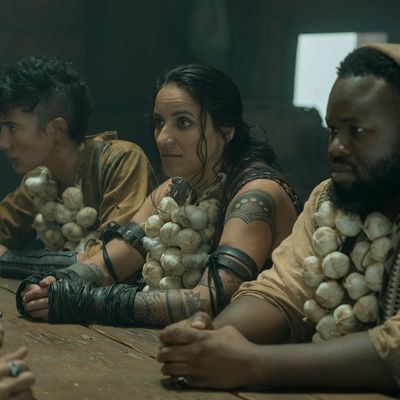
The gang’s back again, and thank goodness for that. The opening run of Our Flag Means Death season two had its charms, but the show just clicks when Stede and Ed are together. The chemistry between Rhys Darby and Taika Waititi is a big part of this — the scene early on in “The Curse of the Seafaring Life” where they discuss Stede’s “mean voice” is a wonderful example. But resolving (for now, at least) the show’s central conflict also frees its writers to go on lively tangents like the ones in this week’s episodes.
“Fun and Games” did the work of reuniting our estranged lovers, letting them hash out their resentments and misunderstandings while surrounded by baroque furniture, squabbling lesbians, and an indoor goat. (Tuesdays, am I right?) Stede is confused about Ed’s mumbling about mermaids as the pirate formerly known as Blackbeard disembarks from the Revenge on his way to exile on a nearby island. Then Buttons — whose exit from the narrative at the end of episode four is the most definitive one we’ve gotten all season — explains the whole “gravy basket” thing. This softens Stede’s already tender heart. And once Ed can lower his defenses just a bit and express himself with words rather than violence, it doesn’t take long (like, mere seconds) for the dynamic between them to get back to normal.
Maybe they see their future in the relationship between episode four guest stars Anne Bonny (Minnie Driver) and Mary Read (Rachel House, another New Zealander on a show full of them), retired pirates who have retreated to what appears to be an abandoned island to open an antique shop. (Not a lot of foot traffic out there.) Bored and isolated, they’ve turned to what I can only describe as kinky pirate stuff — a light poisoning here, a tap-tap-tap of a knife between the shoulder blades there — to keep their relationship fresh. As Mary tells the boys between passionate embraces as their dream literally burns around them, “This is what an adult relationship looks like.” And honestly? She’s kind of right!
Everyone is awfully mature in this week’s episodes — Stede, who gives up a very expensive-looking fancy-boy suit (his favorite!) in order to keep the peace; Ed, who accepts his punishment of a sack and a bell while he attempts to regain the crew’s trust; Izzy Hands, who accepts his new appointment as Stede’s trainer/second-in-command with remarkable calmness; Fang, who gives the gift of (at least temporary) peace to a man who’s treated him with nothing but cruelty; and the rest of the traumatized crew, who manage not to kill Ed and instead accept what we would now refer to as “restorative justice” on his behalf. Much like Stede designating the ship a “safe space,” this is one of those modern approaches in a historical setting that are a cornerstone of the show’s humor.
On the other hand, the crew’s thinking after encountering that super-freaky Spanish ship full of dead priests in “The Curse of the Seafaring Life” is very of its time. The Age of Reason had already arrived by 1717 when the story of Our Flag Means Death began. But reading about science and philosophy — and just reading in general — were elite activities at the time, which supports the idea of pitting aristocratic Stede against his working-class crew when it comes to believing in curses, demons, and leaving a little snack out for the fairies after dinner (a real thing, as many of the historical touches on this show are).
The horror elements in the fifth episode — the bloody pentagram on the deck of the cursed ship, the gruesomely posed bodies, and the exorcism-movie whispering on the soundtrack every time the suit appears onscreen — were a fun (and seasonal) diversion as well. Overall, this week’s episodes were the funniest (the physical comedy and pratfalls were especially well-timed) and the freshest ones we’ve seen yet this season. I was also a big fan of Buttons’ “avian transmogrification ceremony” (which opens with “hajimemashite,” Japanese for “nice to meet you”), which blended whimsy and weirdness in a way that felt appropriate for the tone of this series.
All that aside, however, the heart of Our Flag Means Death remains a romantic one. Ed and Stede are taking it slow, learning to trust one another again under the swoony bright moonlight. And Lucius proposes marriage to Black Pete, who enthusiastically accepts. Does that mean we have a pirate wedding to look forward to before the end of the season, possibly with a Runaway Bride twist where Ed knocks Lucius overboard again, but by accident this time? Stranger things have happened and will continue to as long as our crew keeps sailing under its new flag: A white kitty cat with a golden halo.
Davy Jones’ Locker
• Realizing that Ed was reciting the lyrics to “Here I Go Again” by Whitesnake on his pouty march into exile was a funny creeper of a joke.
• “Pirate Queens” Anne Bonny and Mary Read were real people, contemporaries of Blackbeard who fought and pillaged while dressed in men’s clothing and defied superstitions about women bringing bad luck at sea. Bonny is said to have stabbed a crewmate through the heart who suggested as much.
• Captain Charles Johnson — possibly a pseudonym for Robinson Crusoe author Daniel Defoe — strongly suggests that the two were lovers in his 1724 book A General History of the Robberies and Murders of the Most Notorious Pirates, writing that Bonny’s husband, the pirate captain Calico Jack, once threatened to slit Read’s throat out of jealousy.
• You can tell that Izzy Hands is having the toughest time adjusting out of everyone because the dude is just so wet. Soaked, all the time, for no reason.
• I also noticed right away, as Lucius does, that Ed’s “apology” didn’t actually include the words “I’m sorry” — a side effect of reading celebrity apologies for a living for a couple of years.
• EpiPens weren’t invented until the 1970s, so Frenchie is lucky his peanut allergy wasn’t that bad.
• Marriage between men, referred to as “matelotage,” was common at sea in the early 18th century. In that adorable way — they often do when faced with evidence of homosexuality in times past — historians have tied themselves into knots, insisting these “marriages” were actually platonic property-sharing agreements. Sure.
• “Fuck yeah, brother. Fly!”




